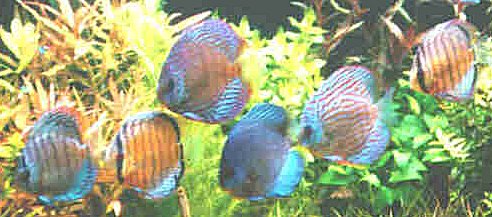
The Planted Discus Aquarium
Copyright 2001 by George and Karla Booth
Why is it that discus seem so magical? Perhaps it's because they have the reputation as being difficult
fish to keep and are only worthy of the most experienced aquarists or maybe it is their regal demeanor.
After all, they are often described as "King of the Aquarium". Anyone who has seen a magnificent
breeding pair will have to agree it's a sight to behold. If you have ever had the chance to browse some
of the discus books on the market, you will realize that few fish can create an impression like discus, and
a school of them in a large tank is simply awesome.
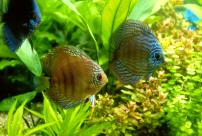 As aquatic plant enthusiasts, we naturally gravitate towards spectacular aquariums. A large, carefully
aquascaped display can hold us spell-bound for hours. Many aquatic gardeners have wondered about combining
discus and live plants. Would the combination be as remarkable as the pairing of peanut butter and
chocolate? Mr. Takashi Amano, the author "Nature Aquarium World", certainly seems to think so - some of
the most impressive photos in his books are of planted discus tanks. Followers of the recent Aquatic
Gardeners Association Aquascaping contest noted that quite a few of the entries featured discus in an
aquatic garden.
As aquatic plant enthusiasts, we naturally gravitate towards spectacular aquariums. A large, carefully
aquascaped display can hold us spell-bound for hours. Many aquatic gardeners have wondered about combining
discus and live plants. Would the combination be as remarkable as the pairing of peanut butter and
chocolate? Mr. Takashi Amano, the author "Nature Aquarium World", certainly seems to think so - some of
the most impressive photos in his books are of planted discus tanks. Followers of the recent Aquatic
Gardeners Association Aquascaping contest noted that quite a few of the entries featured discus in an
aquatic garden.
But is a planted discus tank as simple as dropping a Hershey bar into a jar of Skippy peanut butter? If
you are guessing "Not Exactly", you are right. But it is not as difficult as you might imagine. We have
successfully maintained planted discus tanks for 15 years. This article is based on our experiences and
hopefully will give you the knowledge and confidence needed to create your own spectacular discus
habitat.
The Good and the Bad (but not Ugly)
 There are several advantages to keeping discus in a planted aquarium. The most obvious advantage is
the sheer beauty of this combination. Discus tend to be slow moving and graceful fish and look perfectly
at home amid plants slowly swaying in the current. Their coloration, especially the metallic turquoise
variants, is a perfect match to the natural greens and reds of live plants. And, especially important to us
aging aquatic gardeners, discus are big fish and are easier to see from the sofa compared to the more
typical tetras found in our displays!
There are several advantages to keeping discus in a planted aquarium. The most obvious advantage is
the sheer beauty of this combination. Discus tend to be slow moving and graceful fish and look perfectly
at home amid plants slowly swaying in the current. Their coloration, especially the metallic turquoise
variants, is a perfect match to the natural greens and reds of live plants. And, especially important to us
aging aquatic gardeners, discus are big fish and are easier to see from the sofa compared to the more
typical tetras found in our displays!
On a more serious note, plants are known to act as chemical filters to help remove toxic substances
from the water. This is a very important attribute for a discus tank. Discus are sensitive to water quality
and they place more of a demand on the aquarist to maintain high standards. A good collection of
healthy plants will lead to a healthy overall environment and will help stave off common diseases like
"hole-in-the-head".
 Plants also provide natural hiding places for discus. Discus tend to be shy fish and are sometimes
bothered by activity outside the tank. Plants are preferred to other tank decorations since a large discus
can easily hurt itself on a piece of driftwood or large rock. Providing a stress-free environment will also
promote good health in your discus.
Plants also provide natural hiding places for discus. Discus tend to be shy fish and are sometimes
bothered by activity outside the tank. Plants are preferred to other tank decorations since a large discus
can easily hurt itself on a piece of driftwood or large rock. Providing a stress-free environment will also
promote good health in your discus.
Broad-leafed plants make nice spawning sites for a breeding pair of discus. While most breeders prefer
a breeding cone or piece of slate, our discus have often spawned on Anubias or Echinodorus leaves.
Plant leaves make good spawning sites in a community tank since the other leaves on the plants help
shield the spawning pair from other inhabitants as well as nosy aquarists.
 There are some disadvantages you should consider before you take the plunge with discus. They are
warm-water fish and typically are kept in water over 80 degrees Fahrenheit. For example, we have
always kept ours at 82 F. The higher temperature will limit to some degree the species of plants that will
do well. We'll discuss this in more detail later.
There are some disadvantages you should consider before you take the plunge with discus. They are
warm-water fish and typically are kept in water over 80 degrees Fahrenheit. For example, we have
always kept ours at 82 F. The higher temperature will limit to some degree the species of plants that will
do well. We'll discuss this in more detail later.
All the discus books recommend feeding discus very well to maximize their growth and to get them in
top condition for breeding. Some breeders offer four or five feedings per day of high protein food like
beef-heart mixtures. The fish have a period of time to eat the food, then the remaining food is vacuumed
from the tank to avoid water quality problems. Partial water changes are done frequently to keep
nitrates very low. Anyone who has maintained a plant tank realizes that trying to clean up uneaten food
and doing lots of water changes is difficult.
With a planted discus tank, a compromise must be achieved . We feed high quality food once per day
and do large water changes every other week. This keeps nitrates fairly low (less than 15 mg/l) but
doesn't allow the fish to get as big as possible. Our fish tend to grow to seven or eight inches in diameter
instead of the ten to twelve inches we have seen in some breeders tanks. The smaller size seems to scale
better to the 100-gallon tanks we use, so we don't see this as a problem. Also, even though we are not
trying to breed them, they do spawn regularly so the reduced rations don't seem to crimp their sex drive.
Lastly, a planted discus tank should be arranged with plants that don't require frequent trimming. Some
discus tend to be shy and spook easily, so the less time you spend digging around in the tank, the better
off they are, and the better they will look. Even the most even-tempered discus will sometimes freak out
and thrash around the tank, possibly injuring themselves on driftwood or equipment.
Viva La Difference
Over the years, the aquatic gardening community has developed many "best practices". A few of these
practices need to be compromised to have a successful planted discus tank.
The most common practice seen in planted tanks is the use of higher intensity lighting to promote fast
plant growth and to accommodate "light loving" plants. The common rule of thumb of "2 to 3 watts per
gallon" is often used as the starting point. Many aquarists mistakenly think "more is better" and brag of
setups using VHO or metal halide bulbs generating 4 or 5 watts per gallon. In general, plants don't need
this much light and this kind of intensity might very well scare the discus into hiding most of the time.
We have been very successful with 1.5 to 2 watts per gallon on our planted tanks. The actual bulbs you
use will greatly influence the amount of light intensity you achieve with any specific wattage. We use high
efficiency tri-phosphor bulbs and end up with about 15,000 Lux at the water surface. This intensity
produces excellent growth and doesn't seem to bother the discus.
The type of lighting may be important. Our very first discus tank used two metal halide (MH) bulbs
suspended above the water. These bulbs create well-defined point sources of light that produce rippling
shadows in the tank from ripples on the water surface. The discus in this tank seemed shyer than in
tanks with fluorescent bulbs. We don't know if it was the shadows, the high intensity point sources or
just coincidence. The average brightness at the surface was also 15,000 Lux.
Another best practice is to achieve an "aged" substrate. Mulm and detritus collect in a planted tank and
many aquatic gardeners leave it there, allowing it to break down and recycle nutrients. This will generally
lead to higher nitrates in the water column. This is to be discouraged since discus like a cleaner
environment and higher water quality than less demanding fish. It is recommended that light gravel
vacuuming be done during water changes to keep excess waste material at a minimum.
Everyone knows that good water circulation is beneficial to plants. To put it simply, plants can't chase
after food like fish can and must depend on the water currents to bring nutrients to the leaves and
remove waste products. Good circulation also improves growth by reducing the boundary layer at the
leaf/water interface allowing CO2 to be absorbed more quickly. Although it would be difficult to
simulate the flow of a river in an enclosed tank, some aquarists strive to do just that by using multiple
filters and powerheads to move water.
Fast moving water in a discus tank in not recommended. Discus tend to be slow movers and have a big
"sail" area due to their round bodies. If faced with a high current situation, they would expend a lot of
energy maintaining their position. They are also slow feeders and might have trouble getting at food
being blown rapidly past them in the currents.
This is not say that a discus tank should be stagnant. Some water circulation is needed to keep the
water oxygenated properly and to allow filtration to do its job. Some strong currents are fine if the
discus have some relatively quiet areas to hang out. In fact, plants with large leaves like Echinodorus can
provide both "wind breaks" and attractive hiding places.
One of the goals of many aquatic gardeners is to have a "dense planting". They aren't satisfied until every
square millimeter of the aquarium substrate is planted. The sight of bare gravel is an abomination to
them. Likewise, the water column itself doesn't look right unless it is solid plant material. These
aquascaping techniques don't work well for a planted discus tank for two reasons. First, discus are
primarily bottom feeders and like to leisurely pick at food lying on the bottom. If the food settles down
into a mass of plants, the fish won't be able to get to it and water quality problems will result. Secondly,
discus are big fish and need room to swim. Obviously, if the tank is solid plants, they won't have much
swimming room. Let's add a third reason - if the tank is densely planted and you can't see the discus,
you've missed the whole point of the exercise!
The last thing to consider is the selection of tank mates for the discus, especially in the area of algae
eaters. Algae eaters are important in a plant tank but should be selected carefully. Again, discus are big
and slow moving and have a tasty slime coat. They make great targets for sucker mouth algae eaters!
Always avoid aggressive algae eaters like "Chinese Algae Eaters" (Gyrinocheilus aymonieri).
 You should also be on the alert for other types known to be more benign. For example, Otocinclus are
generally peaceful algae eaters and are readily available. However, there are many varieties of otos and
the particular species is usually not tracked by the local fish store (unless you are very lucky). We have
had trouble only one time - a group of otos we tried once turned out to be "attack otos" and just loved
to latch onto the sides of the discus, leaving round white areas when the discus finally shook them off.
We have also had minor problems with some Farlowella acus - they also found the discus attractive.
Luckily, the farlies aren't very good at swimming and the discus could easily avoid the oddly wiggling
stick moving towards them.
You should also be on the alert for other types known to be more benign. For example, Otocinclus are
generally peaceful algae eaters and are readily available. However, there are many varieties of otos and
the particular species is usually not tracked by the local fish store (unless you are very lucky). We have
had trouble only one time - a group of otos we tried once turned out to be "attack otos" and just loved
to latch onto the sides of the discus, leaving round white areas when the discus finally shook them off.
We have also had minor problems with some Farlowella acus - they also found the discus attractive.
Luckily, the farlies aren't very good at swimming and the discus could easily avoid the oddly wiggling
stick moving towards them.
The very popular "Siamese Algae Eater" (Siamensis crossocheilus) is very useful in a plant tank but may
cause problems with discus. Siamese Algae Eaters are very fast swimmers and, likewise, very fast
eaters that may out-compete the discus for food. However, we have always kept them with discus and
have not had any problems. They will definitely grab for any food offered, but don't seem to eat that
much even when full grown. There is still plenty of food left for the discus.
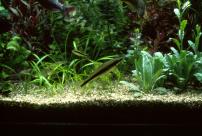 On the same note, be careful when choosing other fish to keep with discus. Don't choose fast swimmers
that may startle the discus and don't choose fast eaters that will eat their food. One of the best and most
complementary fish is the Cardinal Tetra (Paracheirodon axelrodi). A good strategy is to introduce
cardinals when the discus are still juveniles and let them grow up together. Otherwise, the small cardinals
usually found in fish shops may become a very expensive dinner for full-grown discus.
On the same note, be careful when choosing other fish to keep with discus. Don't choose fast swimmers
that may startle the discus and don't choose fast eaters that will eat their food. One of the best and most
complementary fish is the Cardinal Tetra (Paracheirodon axelrodi). A good strategy is to introduce
cardinals when the discus are still juveniles and let them grow up together. Otherwise, the small cardinals
usually found in fish shops may become a very expensive dinner for full-grown discus.
Another nice fish to keep with discus is a school of Corydoras. Bottom feeders will help keep uneaten
food from becoming a problem and corys are everyone's favorite. They do best in schools, so get a
half dozen of one of the smaller species like C. trilineatus to act as your groundskeepers.
A fish to avoid is the common angelfish (Pterophyllum scalare). They are known to carry parasites
harmless to themselves but fatal to discus and, like most other cichlids, are fast eaters.
Optimizing the Discus Environment
Discus are widely known to prefer soft, acidic water. In nature, the Amazon black-water biotope is
extremely soft, rather murky and has a low pH. However, since the discus you have are probably far
removed from the Amazon, the environment you design for your discus should actually match the
environment in which they were raised. This means contacting the discus breeder, if possible, to
determine the conditions to which your fish are accustomed.
Another factor determining your set up is whether you desire to breed the fish or display them. Breeding
will demand a closer match to an "optimum" set of water parameters; a display tank will require less
stringent needs. If you are not trying to optimize for breeding, the best idea is to select conditions you
can easily achieve when changing water to provide a stable environment. It is far better to settle for
harder, more alkaline water than to have to struggle with elaborate water softening and pH adjusting
equipment and chemicals.
Tank Size
 One mistake many beginning discus keepers make is to use too small of a tank. Most young discus are
sold when they are quarter- or half-dollar size. It is easy to assume that six or eight would fit nicely in a
20-gallon tank. Nothing could be further from the truth. Breeders recommend about 40 gallons as the
minimum size for a pair; I would extend this rule to display tanks also. We have kept four to six adults in
a 100-gallon tank and that seems just about right. It is important to consider both volume and scale - a
taller tank (24") is preferred to a lower, longer tank since discus are round. An 8" discus is much taller
than a typical 8" fish!
One mistake many beginning discus keepers make is to use too small of a tank. Most young discus are
sold when they are quarter- or half-dollar size. It is easy to assume that six or eight would fit nicely in a
20-gallon tank. Nothing could be further from the truth. Breeders recommend about 40 gallons as the
minimum size for a pair; I would extend this rule to display tanks also. We have kept four to six adults in
a 100-gallon tank and that seems just about right. It is important to consider both volume and scale - a
taller tank (24") is preferred to a lower, longer tank since discus are round. An 8" discus is much taller
than a typical 8" fish!
One idea is to start with a larger number of juvenile discus than you intend to keep and cull the weaker
or less attractive fish as necessary. We have found that in any batch of juveniles, some will be dominant
and some will be submissive. In our experience, the submissive fish will die off, either because they don't
eat well or are picked on by the others. If your local fish shop takes trades, you may be able to give
some of the young discus back (they may do well in another tank where they may become the dominant
fish).
Softer Water
We are lucky to have very soft water directly from the tap. Our water comes from mountain reservoirs
and is primarily snow melt. It averages about 0.5 to 1 degree General Hardness (GH or
calcium/magnesium hardness). This level of calcium hardness may be fine for a discus-only tank but we
feel it is too low for good plant growth. We add calcium carbonate to boost the GH to about 2 degrees.
In our 100-gallon discus tank, this works out to about 4 teaspoons (8 grams) of reagent grade CaCO3.
| Note: For reference, two teaspoons (about 4 grams) of calcium carbonate per 50 gallons of water will
increase both General Hardness (GH) and Carbonate Hardness (KH) by approximately 1 degree.
One teaspoon (about 6 grams) of sodium bicarbonate per 50 gallons of water will increase KH by
about 1 degree and will not increase GH. Always use a test kit to determine if you are adding enough
hardening agents - it is very difficult to get accurate measures of dry chemicals without sensitive
laboratory scales. With most common aquarium test kits, 1 degree of hardness (dGH or dKH) is
equivalent to 17.8 mg/l of CaCO3, the standard for measuring hardness. |
Lower pH
Even though discus are thought to prefer lower pH values, we like to keep our display tanks around pH
6.9. For us, this means adjusting KH and CO2 levels to achieve the desired pH. In a non-planted
situation, various commercial pH-adjusting compounds could be used to adjust pH. However, these
usually contain phosphates and will lead to algae problems in a planted tank with higher lighting and
nutrient levels.
To set the pH, we add sodium bicarbonate (NaHCO3, common baking soda) to increase the KH of
our tap water from 2 degrees up to 4 degrees (the equivalent of about 70 mg/l CaCO3). Note that the
calcium carbonate added earlier to increase GH will also increase KH; always check KH after
increasing GH to see how much sodium bicarbonate you need to add. In our case we add 2 teaspoons
(12 grams) of reagent grade NaHCO3 to get a final value of 4 dKH.
| Note: Most KH test kits actually measure total alkalinity. If carbonate is the only buffer in the water,
total alkalinity equals carbonate hardness. If there are other buffers in the water, such as phosphates,
you will not get a true KH reading from a KH test kit. Plan accordingly. |
The second part of the pH equation is CO2. When KH is increased, pH will also increase. To bring the
pH back to where we want it and to provide plants with enough CO2 to grow well, we inject CO2 to
achieve a concentration of 15 mg/l. That concentration of CO2 and 4 dKH will set the pH at 6.9. There
are many copies of the KH/CO2/pH tables available on the Internet so you can juggle the KH and
CO2 to suit your own requirements. We recommend that you do not exceed a CO2 concentration of
more than 15-20 mg/l with discus.
We prefer to use a pH controller that measures pH in the tank and turns on or off a solenoid to control
the flow of CO2. With care, you can use a manually controlled CO2 system to do the same thing. After
getting the KH to the right level, simply adjust the CO2 flow until the tank has the pH that you desire.
Higher Temperature Water
Aquarists have found that discus have better disease resistance at higher temperatures and will set the
water temperature anywhere between 80 F and 86 F (27 C to 30 C) or higher. We find that algae
seems more problematical at higher temperatures and we like to stay towards the lower end of this scale
- about 82 F.
One positive aspect of higher temperature is that undergravel heating coils are not such a problem as
they are at lower temperatures. Aquarists who don't live in air conditioned houses find that aquarium
temperatures in summer months get into the 80 F range and thwart the use of undergravel heating coils -
extra heat is not needed and the cables sit idle.
Oxygenation
Due to higher water temperatures, there is less oxygen capacity in the discus tank. At sea level, oxygen
saturation in water at 75 F is 8.4 mg/l; at 86 F it is down to 7.6 mg/l. This is even more critical if you are
at higher elevations - the combination of high altitude (we are at 5000 feet) and warmer water further
reduces oxygen levels. A planted tank is very useful for discus since the plants can supersaturate the
water during the day, pushing oxygen levels to 120% of saturation or more. We will typically see O2
levels of 8.3 mg/l in the evening - equivalent to cool water at sea level.
As a further safety measure, we use trickle filters to ensure that water stays well oxygenated even at
night when the lights are off and plants stop photosynthesizing. We note that that oxygen levels are about
90% in the morning before the lights come back on. This same level can be achieved by running
airstones at night but at the expense of dramatic CO2 loss.
Plant Recommendations
A final aspect of a planted discus tank is the selection of plants that are low maintenance. The less you
are digging around in the tank, the happier the discus will be! Low maintenance will generally mean
slower growing; avoid some of more common stem plants like Hygrophila and Ludwigia .
First time discus keepers are often concerned about the plants they can use in a discus tank. The main
concerns are usually soft water and higher temperatures. We have found that there is really no problem
with growing plants in these conditions (with a few exceptions). We feel that the size, shape and
maintenance requirements of the plants used are more important.
Echinodorus
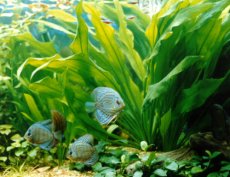 An obvious choice of plants for a discus tank is the Echinodorus family. They are native to the Amazon
basin although they might not be found to a great extent in the black water areas favored by discus.
Echinodorus come in many sizes and shapes and can be used to great effect in discus tanks.
An obvious choice of plants for a discus tank is the Echinodorus family. They are native to the Amazon
basin although they might not be found to a great extent in the black water areas favored by discus.
Echinodorus come in many sizes and shapes and can be used to great effect in discus tanks.
For a centerpiece plant, it is hard to beat a healthy Amazon Sword (Echinodorus bleheri). The large
graceful leaves, the bright green color and the lovely fountain shape make this a classic large-aquarium
plant. It works well with discus because its scale is just about right - leaves can grow to 24" or more
and it can occupy a fairly large area of the tank. Discus can easily hide among the leaves. The size and
shape of the leaves make them suitable for spawning sites, although discus may prefer a more solid
surface.
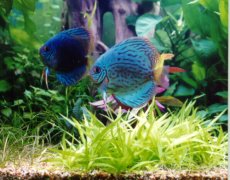 Other sword plants suitable for the main focus of the tank are E. amazonicus, E. major, E. cordifolius
and their many variants. A very popular and attractive variant is the Ozelot sword developed by Tropica
in Denmark.
Other sword plants suitable for the main focus of the tank are E. amazonicus, E. major, E. cordifolius
and their many variants. A very popular and attractive variant is the Ozelot sword developed by Tropica
in Denmark.
Echinodorus include many plants that are perfect for accent or foreground plants. There are a variety of
dwarf chain swords that are prefect for foregrounds. The very popular E. tenellus has a grass-like
appearance and is easy to grow. Larger varieties like E. quadricostatus and E. latifolius make a nice
transition between foreground and centerpiece plants.
Anubias
The Anubias family represents a large collection of plants from Africa. Although not indigenous to the
discus biotope, they are very useful as background and accent plants. They contrast nicely with
Echinodorus since they tend to be a darker green and have a different leaf shape. They are also very
sturdy plants that provide good spawning sites.
Anubias are good for almost any type of aquarium, as they are very undemanding. They will tolerate low
light levels, but they really thrive with higher light and CO2. It is not uncommon to see them sprout
underwater flowers frequently under optimum conditions. They do better in harder water but we have
had no problems with them in our set ups.
The easiest to find are the Anubias barteri variants. Anubias barteri tends to be a big plant with
horizontal leaves up to 6" long. The nana variety is a smaller plant that is good for fore- or mid-ground
detail. A rarer variant known as A. coffeeafolia has deeply incised leaves and is very attractive in the
mid-ground.
There are other types of Anubias, such as A. afzelli and A. congensis, that are more suited for taller
tanks. These tend to have vertical petioles and leaves and look much like sword plants. These are also
good candidates for discus tanks but may not do as well in soft, warm water.
Taller, thinner plants
Other plants useful in a discus tank are those that have a taller form factor to keep a strong vertical
theme in the aquascaping. Also keep in mind contrast and textures.
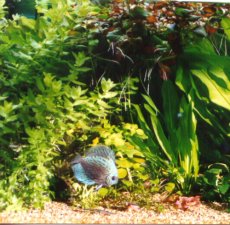 Members of the Crytocoryne family, especially C. wendtii and C. blassi, are very nice accent plants
with their strong vertical shapes and dark colors. There are many variants of C. wendtii, so you can find
a range of pleasing leaf shapes and sizes to suit foreground uses. We have not noticed any problems
with crypts in soft, warmer water.
Members of the Crytocoryne family, especially C. wendtii and C. blassi, are very nice accent plants
with their strong vertical shapes and dark colors. There are many variants of C. wendtii, so you can find
a range of pleasing leaf shapes and sizes to suit foreground uses. We have not noticed any problems
with crypts in soft, warmer water.
The two members of the Ammania family, A. gracilus and A. senegalensis, work very well in a discus
tank. They are not extremely fast growers and make a very attractive red accent plant. They can be
propagated by pruning and replanting the top and allowing new shoots to develop at the cut in the
remaining stem.
Some members of the Bacopa family are cool water plants and may not be suitable for a discus tank.
However, we have used B. monnieri in our tanks as both an accent plant and as background plants. It is
a fairly slow grower and has a nice bright green color.
We have also had good luck with the following plants in discus tanks:
- Java Fern, Microsorum pteropus
- Micranthemum family
- Hydrocotyle family
Less Useful Plants
There are some plants that are just not recommended for the discus tank. Many of the plants native to
North America are adapted to cooler water and may not do well. We have experimented with the
following plants and found them to be intolerant of warmer water:
- Samolus parviflorus
- Amoracia aquatica
- Bacopa caroliniana
 Other very common aquatic plants are either fast growers or produce dense foliage and may require too
much pruning. These would be useful for getting a general plant tank started but should be removed later
on for a discus tank:
Other very common aquatic plants are either fast growers or produce dense foliage and may require too
much pruning. These would be useful for getting a general plant tank started but should be removed later
on for a discus tank:
- Hygrophila family
- Ludwigia family
- Rotala family
- Large Vallisneria family (unless kept under control)
Plants and Romance
Are plants compatible with breeding discus? The final answer is - Yes and No. In some ways, plants
are very good for a breeding tank. A nice arrangement will allow a breeding pair to set up and defend a
territory. This in itself is a strong plus factor. And the better water quality usually seen in a planted tank
is also beneficial. We have many discus pair up and begin spawning in our display tanks. One time we
even had two pairs spawning at the same time on opposite ends of a 100-gallon tank.
But there are enough drawbacks to make a planted tank less than ideal for breeding discus. We think
the biggest obstacle is the inability to provide the maximum amount of food required to grow the
breeding pair to a robust size and maintain them in best breeding condition. Discus breeders like to feed
large amounts of high protein food such as beef heart mixtures. If any uneaten food like this is left in the
tank, problems will surely arise. This is best done in a bare tank set up for breeding purposes.
Even though we have had many pairs spawn in our display tanks, none of the fry have gotten very far
past the free-swimming stage. Our display tanks are community tanks with other discus and fish such as
cardinal tetras and algae eaters. The parents do a great job of defending the eggs and the very young fry
but just can't keep track of a large school of little ones zipping around the tank.
Our advice would be to use a display tank for the purpose of raising young discus to breeding size and
then set up a special purpose breeding tank when some of them pair off and begin to breed.
Author's Biographies:
George and Karla Booth have been planted tank enthusiasts since 1970. They set up their first
"modern" planted tank in 1986 when they began using CO2 injection and other innovations introduced
in "The Optimum Aquarium" by Horst and Kipper. Since then they have authored numerous articles for
the Aquatic Gardeners Association newsletter and various aquarium magazines. They live in Ft. Collins,
Colorado.
 As aquatic plant enthusiasts, we naturally gravitate towards spectacular aquariums. A large, carefully
aquascaped display can hold us spell-bound for hours. Many aquatic gardeners have wondered about combining
discus and live plants. Would the combination be as remarkable as the pairing of peanut butter and
chocolate? Mr. Takashi Amano, the author "Nature Aquarium World", certainly seems to think so - some of
the most impressive photos in his books are of planted discus tanks. Followers of the recent Aquatic
Gardeners Association Aquascaping contest noted that quite a few of the entries featured discus in an
aquatic garden.
As aquatic plant enthusiasts, we naturally gravitate towards spectacular aquariums. A large, carefully
aquascaped display can hold us spell-bound for hours. Many aquatic gardeners have wondered about combining
discus and live plants. Would the combination be as remarkable as the pairing of peanut butter and
chocolate? Mr. Takashi Amano, the author "Nature Aquarium World", certainly seems to think so - some of
the most impressive photos in his books are of planted discus tanks. Followers of the recent Aquatic
Gardeners Association Aquascaping contest noted that quite a few of the entries featured discus in an
aquatic garden.










